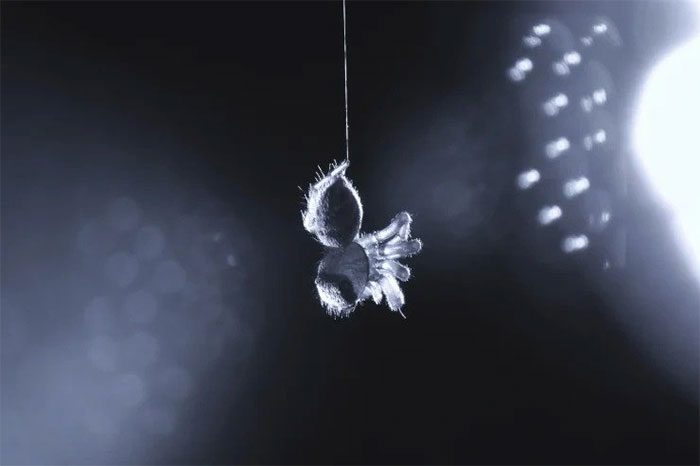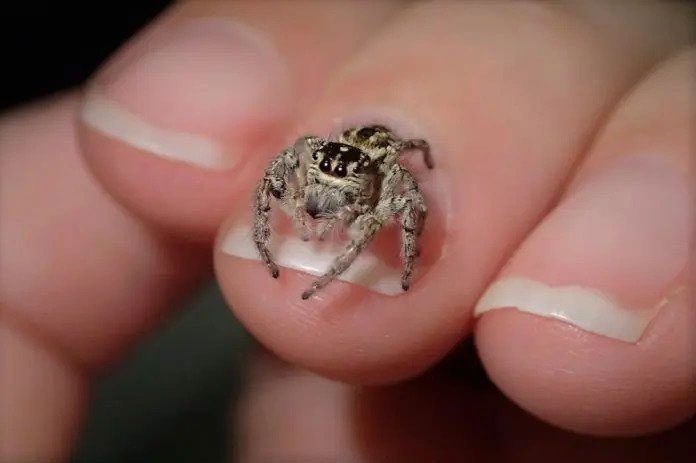Researchers Discover Jumping Spider Species Exhibiting R.E.M. Sleep Similar to Humans.
After a day of stalking and pouncing on prey, the jumping spiders of the species Evarcha arcuata may also be dreaming as night falls.
When these jumping spiders start twitching their legs and moving their eyes, it indicates they are in R.E.M. sleep (Rapid Eye Movement), according to a report published in the Proceedings of the National Academy of Sciences.
R.E.M. sleep is a common state in humans, but new research has shown that R.E.M. may occur in animals more widely than previously thought. This could help unravel the mystery of the purpose and evolution of R.E.M. in animals.
Lauren Sumner-Rooney, a sensory biologist at the Leibniz Institute for the Analysis of Biodiversity and Evolution in Germany, remarked: “Discovering R.E.M. sleep in a creature so distant from humans, like a spider, is quite fascinating.”
Daniela Roessler, a behavioral ecologist at the University of Konstanz, Germany, and a co-author of the study, observed that sometimes jumping spiders hang upside down at night.
Dr. Roessler recorded footage of the spiders while they rested and noticed some unusual behaviors. “Suddenly, they would move their legs frantically and twitch. This reminded me of a dog or cat sleeping,” she said.

A jumping spider twitching its legs in a state resembling R.E.M. sleep. (Photo: AP).
Such twitching movements in the limbs are signs of R.E.M. sleep, a state where most muscles are inactive while the brain sends signals similar to being awake, and the eyes continuously move. This state is difficult to detect in animals, especially in those with non-moving eyes like spiders.
However, part of a jumping spider’s eye does exhibit movement. This species has a total of eight eyes, and behind the lenses of its two largest eyes is a light-sensitive retina that can move to scan the surrounding environment.
The body of the jumping spider often obscures the aforementioned banana-shaped retina, unless they are spiderlings with transparent exoskeletons. Therefore, Dr. Roessler’s research team focused on observing the moving retina of spiderlings under ten days old while they rested.
The researchers recorded the spiders using infrared cameras at night. Out of 34 spiders, they observed episodes of retinal movement and synchronized limb twitching, typically lasting about 80 seconds and occurring every 15 to 20 minutes. They documented the behavior of jumping spiders, from spinning silk to twitching their legs as if they were dead.
Monitoring the spiders sleeping for hours did not make Dr. Roessler sleepy. Each movement of the spider was unique, keeping her eagerly anticipating the next R.E.M. cycle.
Dr. Sumner-Rooney noted that the phenomena the research team observed aligned with several signs of R.E.M.: twitching, muscle relaxation, and eye movement. “They are very similar to phenomena in mammals,” she said.
Scientists have studied R.E.M. sleep in many mammal species. Although it is challenging to identify R.E.M. in other animals, there is considerable evidence that this phenomenon occurs in birds, cephalopods, and one species of reptile.
In arthropods, R.E.M. sleep seems to have appeared long ago and is more common than scientists have previously assumed.
Complex Brain
Dr. Roessler’s team is investigating whether these spiders truly sleep. One way to demonstrate this is to wake a resting spider and a motionless spider to see which one takes longer to awaken.
If the experimental results show that jumping spiders are not merely resting their eight eyes, researchers could gain a broader understanding of the sleep needs of spiders by depriving them of sleep.
If sleep-deprived spiders fall asleep faster and spend more time in a state resembling R.E.M., it would provide further evidence that they do experience R.E.M. sleep.

A small jumping spider with eight complex eyes. (Photo: Exopet Guides).
In fact, sleep and dreaming may offer jumping spiders some benefits similar to those humans receive when they sleep and dream.
“There is no reason to believe they do not dream, depending on how you define dreaming,” said Barrett Klein, an entomologist at the University of Wisconsin-La Crosse. “I can imagine dreaming for jumping spiders involves replaying a memory to allow them to process potential problems.”
With a relatively complex brain compared to its small body, jumping spiders have been shown to possess navigational skills. They hunt insects and other spiders, sometimes preying on targets of similar size. Jumping spiders can perform coordinated movements, jumping from one leaf to another using a silk thread. Some even engage in complex dances to attract mates.
“In my view, the dreams of jumping spiders would relate to their most memorable moments, possibly the most dramatic, in their lives,” Dr. Klein said.


















































